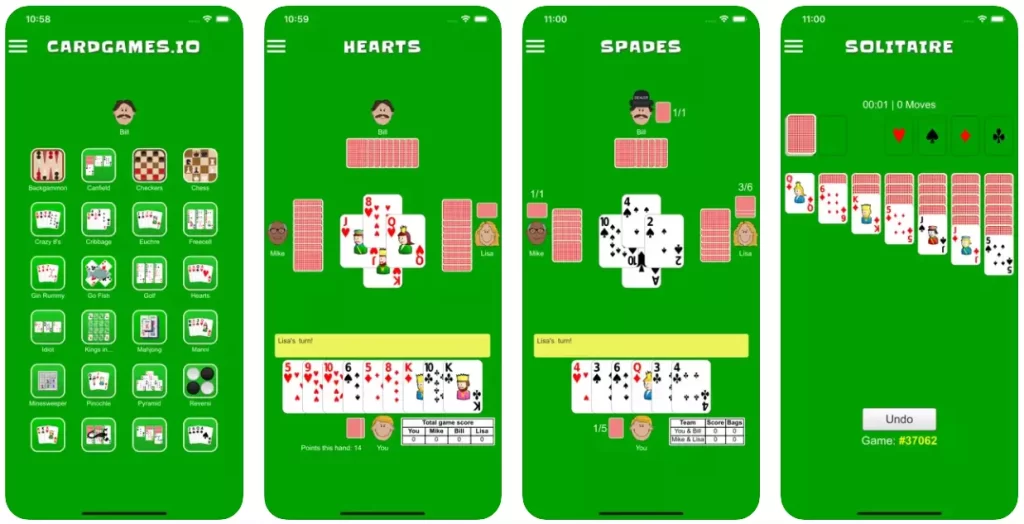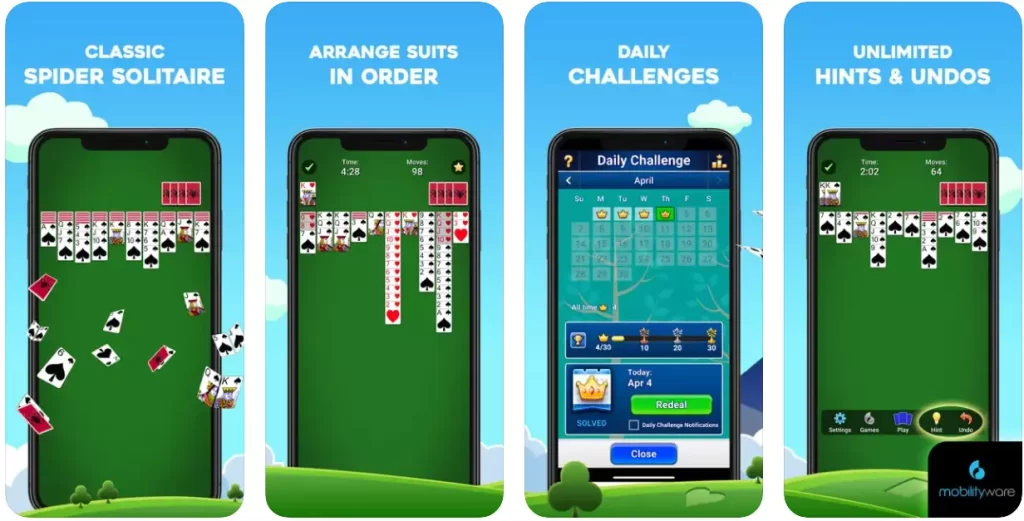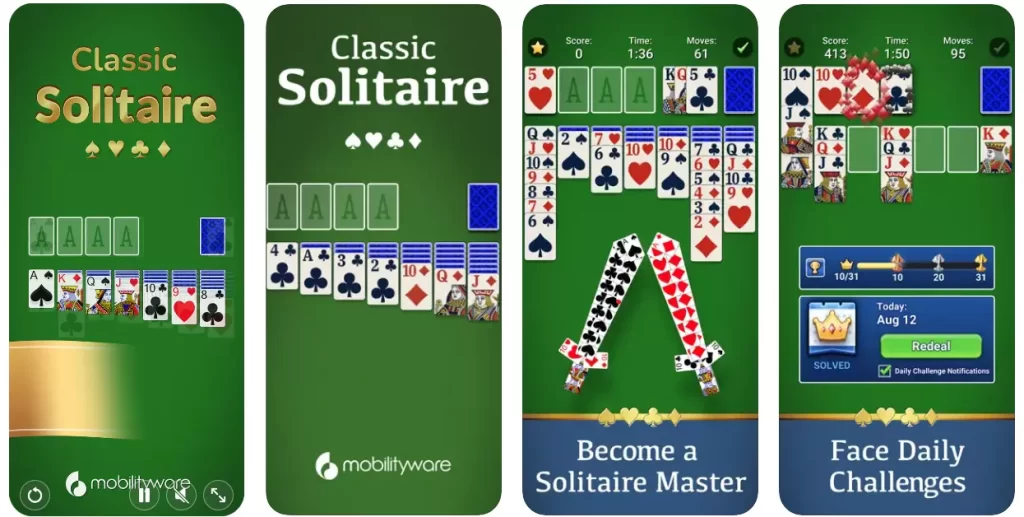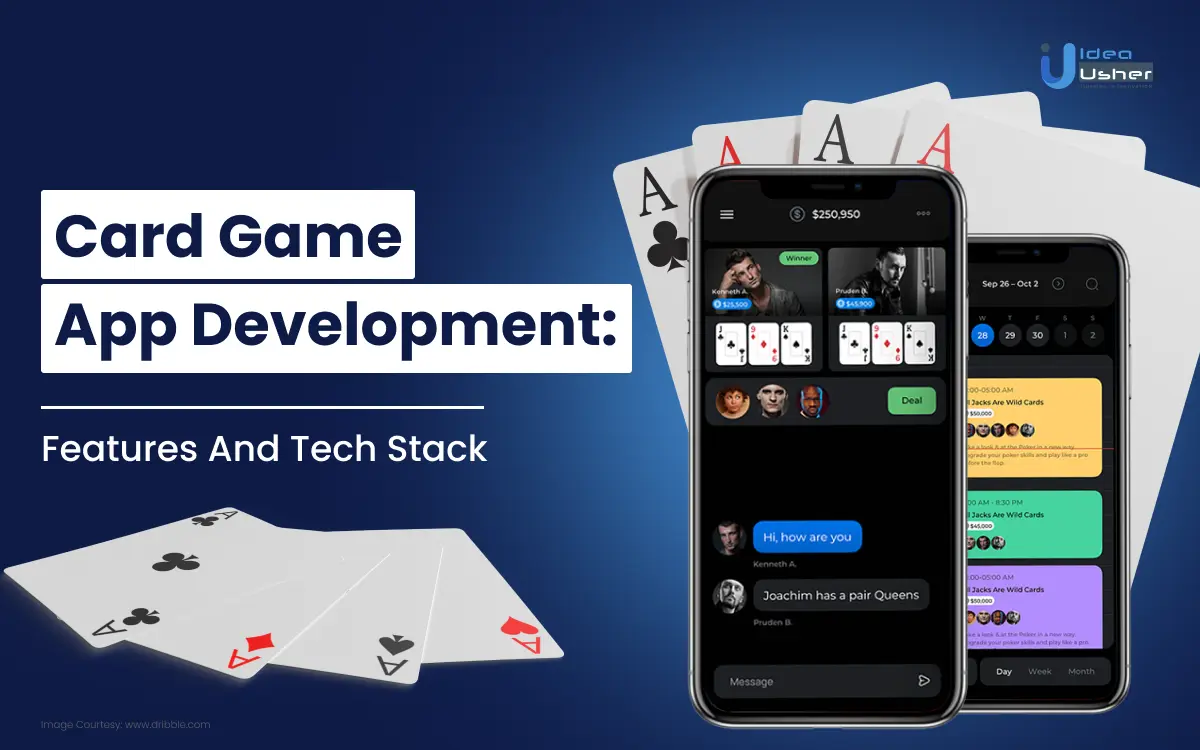With the rise of modern technology and the widespread use of tablets and smartphones, the traditional card-playing experience with cutting-edge technology has opened up a world of opportunities to offer enhanced gameplay experiences.
Thanks to smartphones, card games have gained a vast audience base within a short period of time. The card game app development offers a perfect opportunity for individuals seeking to profit in the card game industry.
In this blog, we will delve into the core concepts and essential elements, including development steps, tech stack, and other crucial aspects to start card game development.
What Are Card Game Applications?
Card game applications are gaming platforms that utilize playing cards as the primary component of gameplay. There are many card games, each with its own rules and objectives.
There is the involvement of boards across all card-playing games where the gameplay depends on the use of cards by players. However, the general rule of card games implies that cards are individually identifiable from one side only, where each player knows the only card they hold.
The card game types basically fall under the given categories: trick-taking games, matching games, shedding games, collectible card games, deck-building games, gambling card games, living card games, war games, solitaire games,
How Card Game App Works?
Card game application provides digital platforms where players can enjoy card games on their mobile devices and computers. Here is an overview of how card game application works.
1. User Interface (UI)
The application offers a user interface where players can engage with card games using touch gestures or mouse clicks. The user interface includes a game board, virtual
cards, and other relevant elements that make card games playable on digital screens.
2. Game Logic & Deck Management
The app contains underlying logic and game rules, including player turns, handling card interactions, scoring, and determining the winner of the game. Moreover, deck management enables the app to control the virtual card decks, shuffling, and card distribution among players during the game.
3. Networking (for multiplayer games)
There is the involvement of networking components, allowing players to connect online with other players, which facilitates real-time online gameplay for connecting worldwide players.
4. Artificial Intelligence (AI) Opponents (for single-player games)
The app includes AI opponents with different difficulty levels, which mimics the human players and offers them challenges based on their AI-based gaming algorithms.
6. Animation and Graphics
The card app often includes sound effects, animations, and graphics to enhance the user experience and make card games more engaging and appealing.
7. Game Progression and Persistence
The card game app often tracks the progress of the current state, such as the game process, saving the current state to allow players to resume their games in case whenever needed.
8. In-App Purchases (optional)
Many card game applications also enable players to buy additional items, such as themes, additional decks, power-ups, etc.
9. Tutorials and Help
Card game applications often include tutorials and help sections to enable new players to learn about gaming rules and understand how to play card games.
Future Business Potential Of Card Game App Development
The competitive nature of the gaming industry encourages developers to innovate, create compelling content, and adapt to changing player preferences.
There are continuous advancements in technology and the increasing popularity of mobile devices, which make the promising future of card game app development. Here are some factors worth noticing that indicate the bright future of card game app development.
1. Growing Mobile User Base
The growing number of worldwide mobile users creates a potential audience base for card game applications.
Since card game applications offer quick gameplay and are easy to learn, the worldwide audience is attracted to card games app.
2. Diverse Game Variations
Wide range of card game applications such as blackjack, solitaire, poker, and many other innovative card-based games offer opportunities for developers to target different audiences based on their preferences and interests.
3. Multiplayer and Social Integration
Card game applications can leverage the power of the internet to facilitate users with online gameplay with multiplayer features such as chat functions, social media integrations, etc., for enhancing the gaming experience.
4. Innovative Technologies
Integrations of innovative technology such as virtual and augmented reality can potentially revolutionize card game experiences, making them more entertaining and engaging for attracting a potential user base.
5. Monetization Opportunities
Card game apps offer various monetization models, such as in-app purchases, advertisements, and subscriptions. Developers can tailor their approach to suit their target audience and game design.
6. Cross-Platform Play
The improvement in cross-platform compatibility enables seamlessly switch between different devices and platforms while maintaining a record of their gameplay progress.
Top 5 Card Game Apps
Explore the top apps offering an enhanced gaming experience to their users in the card game application industry.
1. CardGames.io

A one-stop solution for users interested in playing different games, including puzzle games, Gin, Go Fish, and board games like chess, checkers, and more.
The application offers 35 kinds of different games where players can engage online with other players with their interactive multiplayer gameplay availability. The applications enable their players to access scores statistics of all the games they have played, in addition to different avatars every time they play.
- Developed by: Red Ace Software
- Available on: Android & iOS
- App Downloads: 100K+
- App Ratings: 4.5
2. Spider Solitaire
A fun, free, engaging, and challenging puzzle game that anyone can enjoy. The application offer games ranging from one suit game upto four.
One of the most interesting parts of this game is that the difficulty level gets increase each time the player overcomes the challenges included in the game.

- Developed by: MobilityWare
- Available on: Android & iOS
- App Downloads: 10M+
- App Ratings: 4.6
3. Phase 10: World Tour
As the name suggests, the primary purpose of this game is to encourage players to stay ahead of their gaming phase. The players need to collect a set of cards at every phase and throw them down for everyone to see at the end.
The application enables their players to develop their gaming skills by training their brains to understand patterns and techniques and unlocking new levels.

- Developed by: MobilityWare
- Available on: Android & iOS
- App Downloads: 5M+
- App Ratings: 4.8
4. Gin Rummy Plus
The application provides a worldwide platform where players from different regions can engage and interact with each other by playing interactive card games.
The players can access new games and attend exclusive events within the game. Moreover, with Gin Rummy Plus, the players can enjoy a platform with jackpots and free bonuses as well, where they can easily earn free coins.

- Developed by: Zynga
- Available on: Android & iOS
- App Downloads: 10M+
- App Ratings: 4.5
5. Solitaire
A card game application that comes with pretty simple gaming rules where players need to stick up their cards in order from Ace to King.
The application provides different kinds of difficulty levels, from drawing one card at a time to drawing upto three. Applications also account for daily challenges, where players can earn crowns and trophies and create new titles for their digital profiles.
The Solitaire game often enables their players to change the background, card backs, and card faces.

- Developed by: Mobilityware
- Available on: Android & iOS
- App Downloads: 10M+
- App Ratings: 4.7
Types Of Card Games App
There are vast categories of games that employ card gaming functionality. Each game has its own rules and goals, which makes the game challenging and unique in its own way. The different types of card game apps are as follows.
1. Trick-taking games
A popular kind of card game is designed for two or more players. Different games come within the trick-taking category, where the goal of each game varies. Heart, Spades, and Bridge are some of the popular games that come under trick taking category.
2. Shedding games
The player has to shed their cards, and the first one who discards all their cards wins the game, whereas the person left with cards becomes a loser.
UNO, Crazy Eights, and President are some of the popular shedding games.
3. Matching / Melding games
The main purpose of games under this category is to match the cards where players have to meld a specific group of cards, and the first one able to do so becomes the winner. Canasta and Rummy are examples of melding card games.
4. Solitaire / Patience games
A single-player card game where the term “Solitaire” includes a wide variety of card games with different arrangements and golds.
Popular games such as Tripeaks and Golf have matching components as a player has to pair the cards to discard them from the table until no card remains left.
5. Banking & Staking games
A less-skilled gambling game where luck plays a major role. Blackjack and Baccarat are some of the popular banking games. In contrast, Trente et Quarante, also known as Rouge et Noir, a popular game in European casinos, falls into the Staking games category.
The games under this category involve players that have to face a dealer or banker and have to place bets to acquire better cards.
6. Fishing games
The player has a hand, and the remaining card is displayed face up on the table, where each player plays a card on their turn.
If their card matches any of those displayed on the table, the player can capture and face down close to them; if there are no matches, the player passes the turn to the next player.
7. Catch and collect games
The catch-and-collect games are typically the ones with the simplest gameplay, which are even playable by kids. The deck is equally divided between two players, where players must reveal the top card on their desks.
The card with the highest value captures the others in both are added to the deck of the player, and the first player able to capture all the cards becomes the winner.
8. Collectible card games
The collectible card games include varieties of card games with their own set of rules and structures. Each player has their own personal deck they build by trading or buying individual cards. Pokémon, Yu-Gi-Oh! And Magic is a famous collectible card game.
How Does Card Game App Make Money?
There are various kinds of strategies for making money with card game applications. The most common ways of generating revenue from card game apps are as follows.
1. In-App Purchases (IAP)
This model enables players to buy virtual goods such as card game packs, in-game currency, cosmetic items, power-ups, etc, to enhance the gameplay experience and provide a sense of progression.
2. Advertisement
Offering advertisement promotions are another way of generating revenue from card game applications. The advertisement includes interstitial ads, banner ads, videos, and native ads, which can be displayed between game seasons.
3. Subscriptions
Many card game applications offer subscription models where players can access exclusive benefits such as faster progression, ad removal, access to premium content, etc. The paid subscription can be renewed based on different time sets, such as monthly or yearly.
4. Expansions & Limited-Time Events
The developers can introduce new game modes, new card sets, or additional features for players can pay for their assessment. Moreover, special events, limited-time offers, and promotions can encourage players to spend money in addition to having exclusive discounts.
5. VIP Programs & Sponsorships
Offering VIP programs such as unique benefits, bonuses, or early access to new content enable is another through which card games application makes money. On the other side, card game applications can collaborate with other brands to sponsor their products and services among their users.
Card Game App Development Step by Step
There is a need for careful planning of the process of card game application development, from defining project scope to launching your game to the targeted market.
Follow the steps to build your card game app:
1. Card Game App Market Research
Doing extensive market research will help you understand the scope of developing a card game. Explore various card game applications and find out the most liked features by your targeted users, including user demographics, game market trends, etc.
Conducting market research will help you identify must-have features, monetization models, and other important aspects of card game app development.
2. Decide On Must-Have Features
There are several must-have features that make card games more engaging and enjoyable. Here are some essential features to incorporate in your card game app.
- Gameplay Rules
- Single-player and Multiplayer Modes
- User Authentication and Profiles
- Deck Customization
- Animations and Visual Effects
- Leaderboards and Achievements
- In-App Purchases and Virtual Currency
- Sound Effects and Background Music
- Undo and Hint Options
- Ads and Ad-Free Option
- Responsive Design
- Settings and Preferences
- Offline Mode
- Data Security
- Analytics
- Save and Resume Game
- Push Notifications
3. Create a Card Game App Development Team
A strategic way of team development is another crucial aspect of card game app development. When developing a team, ensure the following members with their respective roles:
- UI/UX designer for designing an interesting and entertaining card game user interface
- iOS developer for developing a card game for the Apple Store while an Android developer for Google Play Store;
- A tester for checking mobile game quality for any flaws or faults
- A project manager for the entire management, including inspecting the team that develops apps, putting the strategy into action, estimating timeframe and cost, etc.
- A business analyst with gaming industry expertise conducts market research and makes recommendations for your app’s success.
4. Perform Storyboarding
After defining all the crucial development roles when creating an app development team, the next step is to start the card game storyboarding process.
The storyboarding will describe the overall game flow from launch to its completion. The developers will create realistic mockups of card games in addition to defining game rules, additional information, etc.
5. Design the Card Game App UI
The engaging UI/UX of card game applications is crucial for enabling your users to access your game more easily and simply.
The developers can utilize popular tools such as Marvel to create visual elements, wireframes, and mockups. Additionally, developers can use various UI techniques to better design themes, and typographies, implementing a great choice of color palette, etc.
6. Develop the Card Game App
The development part includes programming or card game applications as per prototypes built by designers.
There are multiple programming languages, such as C#, C++, Kotlin, Java, Swift, and development tools, such as SceneKit and SpriteKey, that developers can utilize to accelerate the process of game development.
Also, you can consider adding APIs of third-party services to extend the features and functionality of your card game app.
7. Game Engines Selection
A game engine is software that is used to design and build video games.
The game engine provides relevant libraries and tools to accelerate game development, such as a physics engine, graphic rendering engine, sound system, animation engine, memory management scripting feature, etc.
The developers can select from varieties of game engines and can select the suitable one based on their needs and preferences. Here are our top recommended game development engines that you can consider for your card game app development.
- Unity
- Unreal Engine
- GameMaker
- AppGameKit
8. Latest Technologies Integration
Integrating the latest technologies, such as AI, blockchain, and VR, can help you enhance the overall app experience among your app users.
The developers should be familiar with advanced technologies such as VR, machine learning, etc. Utilizing advanced technologies offers new opportunities, such as creating a virtual reality-based card game where users can interact immersively with each other.
9. Test your Card Game App
Your mobile app testers should extensively test your card game app and ensure all features work as planned. They should create real-world scenarios and test the game logic and output. Some of the mobile test cases are compatibility testing, functional testing, recoverability testing, security testing, usability testing, etc.
Inspecting the proper working of your card game will enable you to confirm that your app is working properly. You can test various aspects of an app, such as security testing, recoverability testing, functional testing, compatibility testing, usability testing, etc.
10. Deploy to the App Stores
After testing every aspect of your card game, you can deploy and launch your app to your preferred market, such as Google Play Store, Apple App Store, Web app, etc.
The developers can use valuable tools such as Kobiton to maintain and test your app. The testing tool offers continuous mobile app testing that enables developers to optimize performance and remove code flows before its final launch.
11. Collect User Feedback and Provide App Support
Consider collecting reviews and feedback from your app users to improvise your card game application even further. Based on your user’s feedback and reviews, you can incorporate new features into your app to stay competitive.
Tech Stack For Card Game App Development
The choice of a tech stack for card game app development depends on various aspects, such as the platform you want to target (e.g., mobile, web, desktop), and your preferred programming language.
Here’s a general outline of tech stacks for different platforms:
1. Mobile App (iOS and Android)
I. For iOS (Swift or Objective-C):
- Programming Language: Swift (preferred) or Objective-C
- Development Tools: Xcode (Integrated Development Environment)
- Graphics: UIKit or SwiftUI (for more modern UI)
- Game Engine (optional for complex games): SpriteKit or Unity
II. For Android (Java or Kotlin):
- Programming Language: Kotlin (preferred) or Java
- Development Tools: Android Studio (Integrated Development Environment)
- Graphics: Android’s built-in XML-based UI framework
- Game Engine (optional for complex games): Unity or LibGDX
2. Web App
I. Front-End
- Programming Languages: HTML, CSS, JavaScript (ES6+)
- Frameworks (optional): React, Angular, Vue.js
- Graphics: CSS for styling, Canvas API or SVG for graphics and animations
II. Back-End (for multiplayer functionality or server-based logic)
- Programming Languages: Node.js (JavaScript), Python, Ruby, Java, or others
- Web Frameworks: Express.js (for Node.js), Django (for Python), Ruby on Rails (for Ruby), Spring Boot (for Java), etc.
- Database: MongoDB, PostgreSQL, MySQL, or others
3. Desktop App
I. For Windows
- Programming Language: C# (with .NET framework)
- UI: Windows Presentation Foundation (WPF) or WinForms
II. For macOS
- Programming Language: Swift or Objective-C
- UI: Cocoa (with Interface Builder) or SwiftUI (for more modern UI)
- Programming Language: Python, C++, Java, or JavaScript (with Electron framework)
- UI: Electron (JavaScript-based desktop app framework)
4. Game Engine
Suppose you’re building a complex card game with advanced graphics and animations. In that case, you might consider using a game engine that supports multiple platforms, such as Unity, Unreal Engine, or Godot. These engines allow you to develop once and deploy to various platforms.
Conclusion
A successful card game application development requires a combination of user-centric design, technical expertise, and innovative ideas.
By focusing on the following mentioned metrics, developers can create immersive card game applications that captivate player attention and encourage them to access your platform, ensuring your app’s success in the long run. Therefore working with a reliable app development company is recommended to proceed with your card game app development process in the right direction.
Work with us if you are looking for a team of app developers and professional game designers who can help you create your card game application, from identifying your project needs to launching them to your targeted market.
Here is more information about our game development services for gaining an insight into our expertise in game development. Contact us today to learn how we can help your business grow with our game development solutions.
Contact Idea Usher
Work with Ex-MAANG developers to build next-gen apps schedule your consultation now
Email:
Phone:
(+1)732 962 4560
(+91)859 140 7140
FAQ
Q. How to make card game apps?
A. Consider following the given steps to start card game app development: market research, decide on must-have features, build an app development team, perform storyboarding, design the card game app UI, develop the card game app, game engines selection,
Integrate the latest technologies, test your card game app, deploy your game to the App Stores, collect user feedback, and offer app support.
Q. How much does it cost to develop a card game?
A. The cost of developing a game depends on many factors such as app development infrastructure, feature complexity, Number of UI, etc.
Q. What are the best card games apps?
A. Spider Solitaire, Phase 10, Gin Rummy Plus, Solitaire, CardGames.io are some of the best card game app.





















